|
 
 
Tractate 4 : The Error of Copernicus (continued)
Applying the principle of symmetry to ‘good’ and ‘evil’ becomes the central aspect of many religious perceptions regarding the ‘eternal’ conflict of ‘good’ and ‘evil’.
Philosophically if we apply the same concept of symmetry to ‘life’ and ‘death’ we obtain:

This makes no rational sense in terms of our present day perceptions regarding ‘death’. Scientifically death means ‘end’. What then has philosophy to offer our understanding regarding the perception of life and death in terms of the principle of symmetry?
Philosophy has nothing to offer our understanding regarding life and death but confusion and uncertainty. This confusion and uncertainty spills over to religion and science. The perception diagramed, having no rationality associated with it, causes the very principle of symmetry to take on the perception of being a faulty principle. The perception regarding the principle of symmetry being flawed, attaches a sense of doubt to the scientific and religious principles involving symmetrical perceptions.
If one philosophically accepts death for what it is, one obtains:

And then:

This perception moves ‘death’ from being the opposite of ‘life’ to being a ‘cross-over’ point as opposed to a form of existence. Why does such a graph suggest that death becomes a ‘cross-over point’ as opposed to a form of existence itself? Death has no past and no future. Death is an existence in the present.
If we apply the same graphic actions to this philosophical depiction as we did to scientific depictions we obtain:
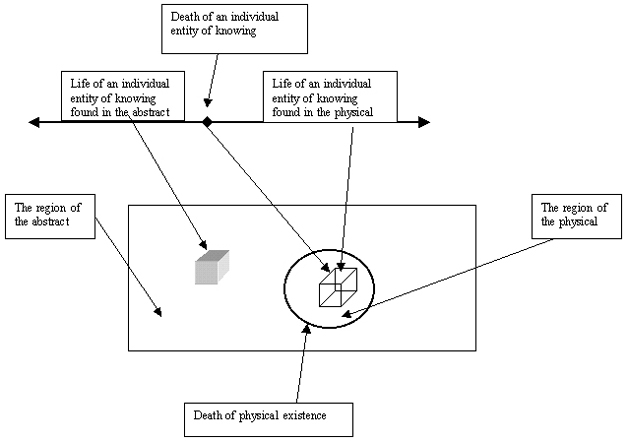
Which, applying the graphics demonstrating the scientific summation of the concepts positive and negative, we obtain:
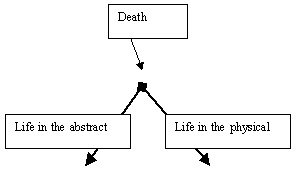
And then
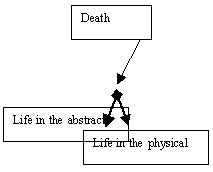
And finally:

Or once again:

‘nothing’
Such a philosophical perception may seem insignificant until one realizes it brings philosophy into line with science and religion. It is philosophy, which takes a lesson from religion/believing and science/observing means of developing perceptions. Is such a lesson important for philosophy? Absolutely. Philosophy has been ‘stuck’ long enough in terms of resolving its most prominent paradoxes. It is time for philosophy to resolve its most perplexing puzzles and move on. Philosophy has no reason to fear its becoming an outmoded form of perception. Resolving the most intriguing philosophical paradoxes will not bring an end to philosophy. Other paradoxes are awaiting discovery but these other paradoxes must wait for philosophy to accomplish its present task, the task of understanding the relationship between the abstract and the physical. Once accomplishing this task, philosophy will find that new, exciting, and even more challenging frontiers await. Such an event occurred with science and it will occur with philosophy.
How can philosophy accomplish its desire to resolve the philosophical paradoxes confronting it for the last twenty-five hundred years? Philosophy simply needs to expand its concept of ‘reality’ to that of ‘Reality’. Philosophy simply needs to embrace the physical with the abstract:
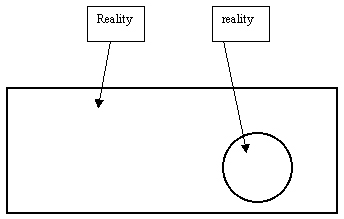
And place the individual entity of ‘knowing’ where we know it to be, within the physical:
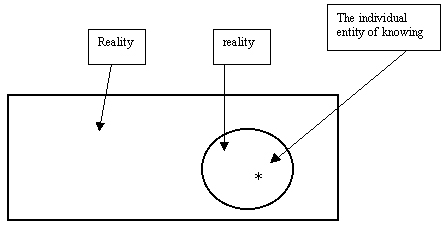
Which is the metaphysical system of ‘being’ being ‘Being’, symbiotic panentheism.
With the application of the principle of symmetry to philosophy, we find the paradoxes of philosophy become manageable and allow philosophy to move on with its task of providing science and religion new perceptions and paradoxes intended to challenge their creative thought and development.
This process does not appear to be a form of ‘inverse proportionality’. This segment of the Tractate appears to deal with the law of symmetry. Therefore why title it: ‘The law of inverse proportionality’?
Philosophy has an obligation to advance thought into active forms of imagery rather than cement thought into static forms of imagery. The law of symmetry, as we saw demonstrated, suggests all concepts, be they physical or abstract, can be reduced to ‘nothingness’ itself. This is not what is being implied by the progressive diagrams illustrated within this section.
What is being implied is something new. What is being implied is the existence of an active form of imagery. What is being suggested is that the abstract exists within the location of abstraction and the abstract also exists within the location of the physical. One location becomes the ‘real’ and the other becomes a ‘real illusion’ yet at the same time, the ‘real illusion’ becomes the ‘real’ and the ‘real’ becomes the ‘real illusion’. Which is which depends upon one’s point of reference. This concept was fully addressed within Tractates 1, 2, & 3. As such, we will not explore such a discussion other than to say:
Philosophically speaking, ‘all’ does not reduce to ‘nothingness’, rather ‘nothingness is the mirror separating one side from the other, separating the ‘real’ from the ‘real illusion’. As such, the principle of symmetry rather than being the principle of symmetry is suggested by metaphysics to be the law of inverse proportionality.
This is no insignificant statement. This statement could revolutionize scientific and religious perceptions. And who said philosophy had nothing new to offer our perceptual development?
But why use the analogy of nothingness representing a mirror as opposed to nothingness being a location of reductionism where all reduces to the lack of everything including the lack of nothingness itself. A mirror is functional. It is not a glass separating one from the other. If one views oneself in a mirror and spends some time examining the opposing image, one realizes that the image is not the same as the object. With some detailed observation, the person viewing their image realizes that their right hand is the images left hand. Thus, a transformation takes place between the object and the emergence of the object’s image as projected by the mirror.
In essence, a form of inversion of the object becomes the image and thus becomes the law of inverse proportionality. This proportion will become an important element in the two tractates, Tractate 7: Hegel and Tractate 9: Einstein.
The ‘location’ of ‘nothingness:
The left becomes the right and the right becomes the left at the boundary. Where is this boundary? The boundary is best described as a mirror. When looking into the mirror one will notice that as one lifts their right hand the mirror image lifts its left hand. As one scratches one’s right ear the mirror image scratches its left ear.
It is often quoted that the eye is the mirror into the soul of a man. What then of the eye one views when looking into the mirror? Is it one’s own soul or the soul of the whole, the soul of God Itself into which one peers?
And what mirror is it of which we speak when speaking of ‘nothingness itself’ It is nothingness which separates the ‘Real’ from the ‘real’. It is nothingness, which acts as the boundary separating the ‘real’ from the ‘real illusion’ (Tractate 1: Zeno). It is nothingness, which acts as the boundary separating the Cartesian from the non-Cartesian (Tractate 2: Aristotle). It is nothingness, which acts as the boundary separating ‘free will’ from ‘determinism’ (Tractate 3: Boethius). And now we in essence are exploring the concept of nothingness separating Centricism from non-Centricism (Tractate 4: Copernicus).
What is perceived by us as ‘nothingness’ has its location as the mirror itself. Nothingness is and nothingness functions as the zero point on a number line. Nothingness allows one side to ‘see’ the other side, to see the image as we saw in the Tractates dealing with the concepts Boethius, Aristotle, and Zeno placed before us. Each philosopher had a dilemma with which to deal and each dealt with their particular philosophical dilemma in their own unique manner.
Zeno, Aristotle, Boethius, and now Copernicus could not see the mirror just as we cannot see the mirror as we gaze into the mirror itself. They each ‘gazed into the mirror and saw what they wanted to see. They saw their right hand scratching their right ear and we, humanity, followed their lead. We, humanity, assumed what they had to say was true and we followed in their footsteps as if the truths they espoused were in fact ‘truths’ when in fact they were simply perceptions, their own personal perceptions, as best they were able to describe them. We assumed what they had to say was fact when in fact it was simply the best they could express the facts they had available to them personally.
We know in part, and we prophesy in part. But when that which is perfect is come, then that which is in part shall be done away. When I was a child, I spake as a child, I understood as a child, I thought as a child: but when I became a man, I put away childish things. For now we see through a glass, darkly, but then face to face: now I know in part: but then shall I know even as also I am known. (Genesis 32:30, 8:2)
To look in a mirror is not to look in a mirror but to look at the inverse of the image, the left becomes the right and the right becomes the left.
Looking into nothingness does not cause us to see into what lies beyond the barrier of our reality but rather allows us to see a vision of what lies there.
To introduce a new concept into the picture, it will be helpful to revert to a simpler diagram than the ones that have been evolving. As such, to understand the concept regarding the ‘location’ of nothingness we will revert to the diagram:
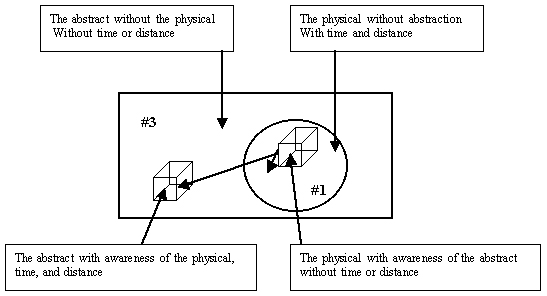
The question now becomes: If nothingness exists, then where ‘could’ it exist? To understand such a discussion it becomes necessary to answer three questions:
- Does ‘nothingness’ exist?
- What is ‘nothingness’?
- Where is ‘nothingness’ found?
Why this order to the questions? The concept regarding the very existence of nothingness evolves even before we define it because it was Boethius who suggested:
‘The cause of this mistake is that people think that the totality of their knowledge depends on the nature and capacity to be known of the objects of knowledge. But this is all wrong.’…
‘The point of greatest importance here is this: the superior manner of knowledge includes the inferior, but it is quite impossible for the inferior to rise to the superior.’…
‘In the same way, human reason refuses to believe that divine intelligence can see the future in any other way except that in which human reason has knowledge.’…
‘… it is quite impossible for the inferior to rise to the superior.’, which in turn implies it is quite illogical for the ‘inferior’, ‘ourselves’, to perceive of either a concept or ‘something’ which is imperceptible to the ‘superior’. (Boethius: The Consolation of Philosophy, Book V, section IV.)
1. Does ‘nothingness’ exist?
We perceive of ‘nothingness’ as the lack of ‘something’. Since we perceive of ‘nothingness’ as a lack of even abstraction itself, it would seem it exists. The very removal of ‘nothingness’ undermines all our present day fundamental cosmological, ontological, and metaphysical debates starting with Boethius himself.
Is the existence of ‘nothingness’ itself an absolute? Strangely enough, removing ‘nothingness’ from our present metaphysical model leads to the eventual termination of the system itself, leaving ‘nothingness’ in place of the metaphysical model we removed. In such a scenario, ‘nothingness’ becomes ‘something’. In essence, a paradox arises equaling that which Boethius wrestled, equaling the paradox regarding free will versus divine foreknowledge.
Within the perspective of the new metaphysical system of ‘being’ being ‘Being’, removing ‘nothingness’ leaves the system intact. Thus, under such a scenario, ‘nothing’ becomes just that ‘nothing’. Within this type of metaphysical system, NO paradox arises.
2. What is ‘nothingness’?
Nothingness is nothing. Nothingness is a void of all.
- Nothing is a lack of matter.
Since matter is perceived to be ‘something’. Nothingness, therefore, must ‘contain’ no matter.
- Nothing is a lack of energy.
With the development of Einstein’s equation demonstrating a direct relationship between matter and energy, energy is perceived to be ‘something’. Nothingness, therefore, must ‘contain’ no energy.
- Abstraction is perceived ‘to be’.
Nothingness is the lack of all, a void of all. If abstractions are a ‘part’ of nothingness, then nothingness is no longer ‘nothingness’. Any existence capable of being subdivided into sub-parts is equal to the sum of its parts. As such, any existence capable of being subdivided is by definition not ‘nothingness’ for by definition it is no longer a ‘void’ of all but rather a sum of all.
What then is ‘nothingness’? Nothingness is definitely not matter. Nothingness is not energy. Nothingness does not appear to be abstraction. It appears nothingness is closer to being energy than matter. Nothingness appears to be even closer to what we perceive to be abstraction than it is to being energy. In all likelihood however, nothingness may be our first glimpse into what acts as the fundamental unit of existence itself.
It is easy to come off task at this point. Moving into a dialectic regarding the topic of nothingness being the fundamental unit of existence itself, becomes an almost irresistible act. However, our task - within this tractate - is to explore the concept of Centricism versus non-Centricism. As such, we must return to work.
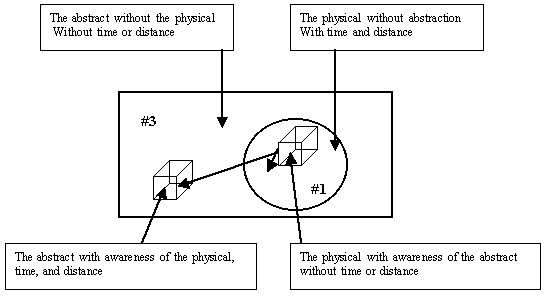
3. Where is ‘nothingness’ found?
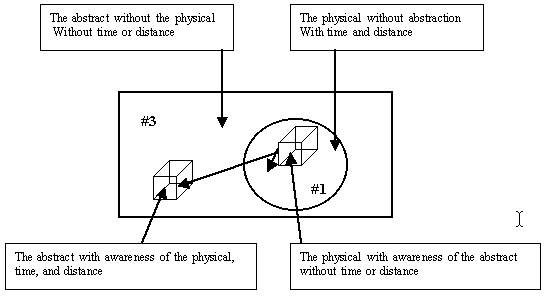
a. Can ‘nothingness’ be found ‘outside’ region #3?
b. Can ‘nothingness’ be found ‘outside’ region #1?
c. Can ‘nothingness’ be found ‘within’ region #3?
d. Can ‘nothingness’ be found ‘within’ region #1?
a. Can ‘nothingness’ be found ‘outside’ the whole, ‘outside’ region #3?
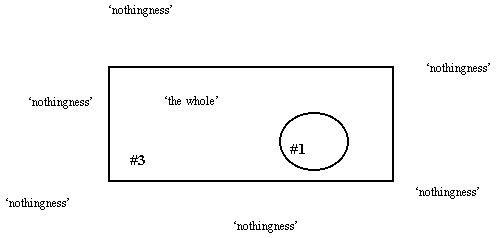
Since ‘nothingness’ in this graphic ‘lies’ ‘outside’ ‘the whole’ the whole to be the whole must expand to include what lies beyond it to remain ‘the whole’. As such we obtain:
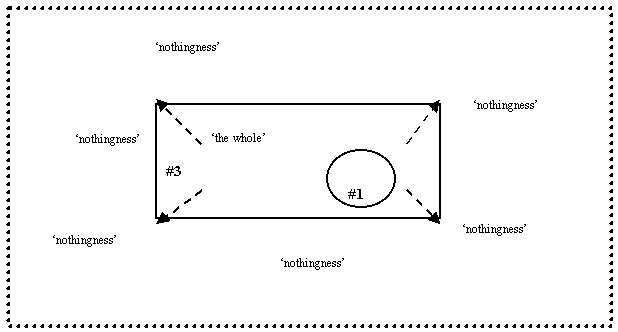
As such the ‘whole’ now becomes:
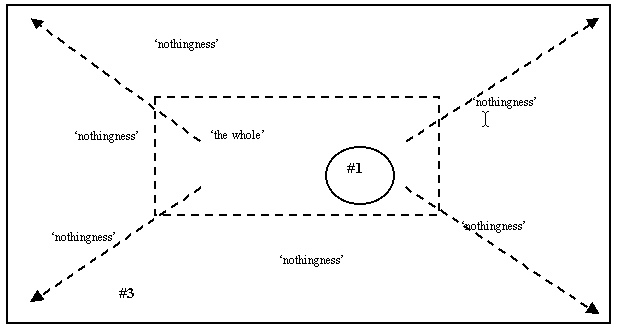
The significant result is that it appears ‘a whole without ‘nothingness" is different from ‘a whole with ‘nothingness".
If ‘nothingness’ exists, it appears to ‘lie’ ‘within’ ‘the whole’. If one places ‘nothingness’ ‘outside’ the ‘whole’, the ‘whole’ must expand to include ‘nothingness’ or it is, by definition, no longer the ‘whole’
Therefore in terms of the question: Can ‘nothingness’ be found ‘outside’ the whole, ‘outside’ region #3? The answer is ‘nothingness’ does not exist ‘outside’ the whole at least from all possible perspectives of the whole itself.
If such is the case, the question arises: Does ‘nothingness’ have a function? As we are about to explore, nothing lacks function within the whole, including ‘nothingness’ itself.
d. Can ‘nothingness’ be found ‘inside’ the physical, ‘within’ region #1?
‘d’? Is this not out of order. Alphabetically, yes it is out of order. Order, however, is not the point here. In fact what we are about to do is examine the concept beginning with the ‘furthest’ ‘outward’ reaches of which we can possibly conceive, followed by the furthest ‘inward’ reaches we can possibly conceive. In short, we are examing the furthest extremes conceivable for ‘nothingness’. Having done so we will then examine ‘nothingness’ in terms of the more moderate points of view.
We will begin exploring the inner most extremes of ‘nothingness with our last graphic.

To better depict the process of examining ‘nothingness’ in terms of the inner most extreme, we will remove the ‘outer’ aspect of our drawing and enlarge region #1:

We will not enlarge region #1:
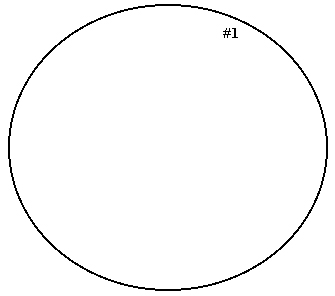
We recognize this as the physical. We often label this region, the universe. Taking the region for what it is we will label it and place a representative of nothingness within this universe.
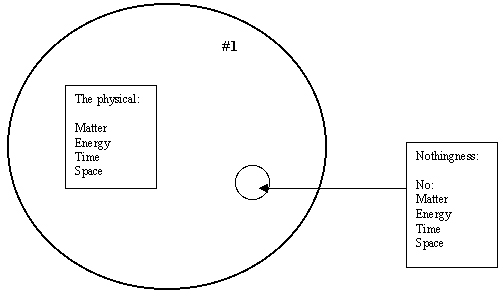
A vacuum is unnatural state of nature but we are not discussing a vacuum, we are discussing a region of nothingness. Not only is nothingness a lack of matter, but nothingness is a lack of energy. We can move to an even greater extreme, for nothingness is not only the lack of matter and energy but nothingness is a lack of matter, energy, and abstractions. Thus time and space would be absent within a region of nothingness.
Some would argue the lack of space and time cannot be found anywhere within the region of the universe and therefore such a concept is irrelevant. Time and space appear to be an innate characteristic of matter and energy. Some would disagree and say matter and energy are innate characteristics of time and energy. This is the old puzzle: which came first – the chicken or the egg? In this particular puzzle, the subject deals with innate characteristic and as such becomes: Are time and space innate characteristics of matter and energy, or matter and energy innate characteristics of time and space?
Since time and space are missing ‘within’ the region of ‘nothingness’, the region takes up no time and space and thus is in essence non-existent from the perspective of the region of the physical.
Therefore in terms of the question: Can ‘nothingness’ be found ‘inside’ the physical, ‘within’ region #1? The answer is ‘nothingness’ does not exist ‘inside’ the physical at least from all possible perspectives of the physical itself.
It might be feasibly possible to either find or create a region in the universe lacking matter and energy but it does not appear to be feasibly possible to find or create a region in the universe lacking time and space for time and space appear to be the very fabric of the universe itself.
b. Can ‘nothingness’ be found ‘inside’ the whole, ‘within’ region #3?
To better understand the answer to this question we must refer back to a diagram found in section: The dynamics of non-Centricism:
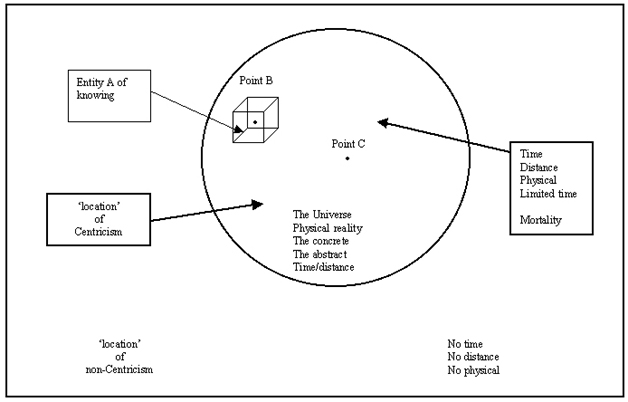
We will ‘reduce’ the graphic to a more manageable form and then add ‘nothingness’ within region 3:
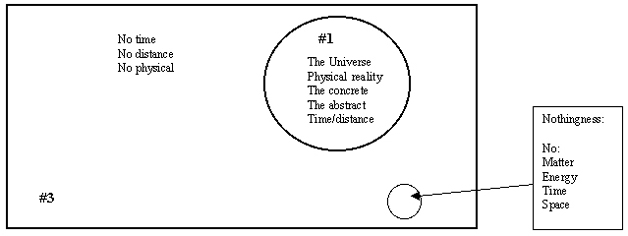
This concept is understandable if one acknowledges an ‘existence’ of the physical lying within the non-physical, lying within the abstract. The question now becomes: Does abstraction lie within ‘nothingness’? The answer would appear to be: If ‘nothingness’ is truly ‘nothingness’ then abstraction itself would be found to be absent ‘within’ ‘nothingness’.
Could such a region exist ‘outside’ the physical but ‘within’ the abstract? The answer appears to be: Yes it is conceivable for the lack of matter, energy, time, space, and all abstraction to exist within a region of abstraction itself.
Therefore in terms of the question: Can ‘nothingness’ be found ‘inside’ the whole, ‘within’ region #3? The answer is ‘nothingness’ does not exist ‘inside’ the physical at least from all possible perspectives of the physical itself but ‘nothingness’ could lie within abstraction, could lie within region #3 if it lies outside region #1.
In short, it might be feasibly possible to either find or create a region within pure abstraction lacking matter, energy, time, and space since time and space are not what the fabric of which the abstract is composed
c. Can ‘nothingness’ be found ‘outside’ the physical, ‘outside’ region #1?
At first glance, this would appear to be the same question as ‘b. Can ‘nothingness’ be found ‘inside’ the whole, ‘within’ region #3?’ Questions ‘c’ and ‘b’ however, are significantly different questions.
Again, graphs will simplify our understanding of the question.
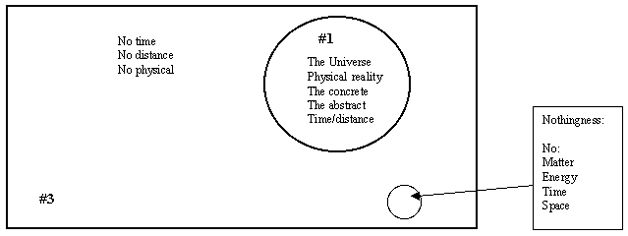
Before we go any further, let’s reiterate a concept presented in Tractate 1: Zeno. The concept: A circle divides existence into three regions: The inside of the circle, the outside of the circle, and the circle itself. We must also reiterate two basic principles of geometry: The first concept: A circle is composed of an infinite number of points in a plane located equidistant from ‘a’ point, the center. The second concept: ‘a’ point is a location in space having no dimensions, having no length, breadth, or depth
With this in mind, we will compress the contents of the circle, compress the universe, apply the contraction aspect of the Big Bang Theory to our diagram.
If we compress the border, separating the physical and the abstract we begin to see the expansion of a region lacking matter, energy, time, and space. In fact, if we follow the logic of ‘b. Can ‘nothingness’ be found ‘outside’ the physical, ‘outside’ region #1?
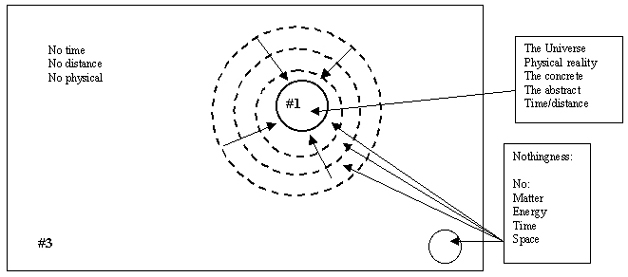
Now we can understand that no matter how much the universe expands or contracts, it remains immersed within a bed of nothingness and therefore takes up ‘no more space’ if it becomes infinitely large than it does if it becomes infinitely small. The reason for this is that it lies ‘within’ ‘nothingness’ which ‘contains’ no time or space, which lacks time and lacks space.
But wouldn’t the universe then lie directly in the abstract? No, for time and space are abstractual and as we have previously demonstrated in this Tractate, ‘nothingness’ is not only the lack of matter and energy but ‘nothingness’ is the lack of all abstractions.
The significance of such a concept now emerges:
The region ‘separating’ the physical from the abstract has no dimension. Matter, energy, time and space do not exist ‘within’ ‘nothngness’ and therefore the boundary separating the physical and the abstract is, from the perspective of the physical as well as from the perspective of the abstract, non-existent.
Now we see that not only can ‘nothingness’ be found within the whole but in terms of the universe, in terms of reality, in terms of the physical which contains time and space, ‘nothingness’ can be found in two places:
- Adjacent to and therefore separating the universe, separating reality, separating the physical, separating multiplicity, separating Cartesianism, separating free will, separating Centricism, separating all aspects of the physical from the abstract
- Non-Adjacent to the universe
Both 1 and 2 have their own implications.
Statement 1 implies ‘nothingness’ is the mirror separating the physical and the abstract. Statement 1 suggests a ‘location’ where the physical and the abstract face one another just as one faces oneself when gazing into a mirror.
Statement 2 implies the existence of multiple ‘realities’. Statement 2 implies the potential of universes existing which do not have time and space as the fabrics of their universes but rather the fabrics of other universes may or may not be composed of other abstractual concepts than the abstractual concepts of space and time.
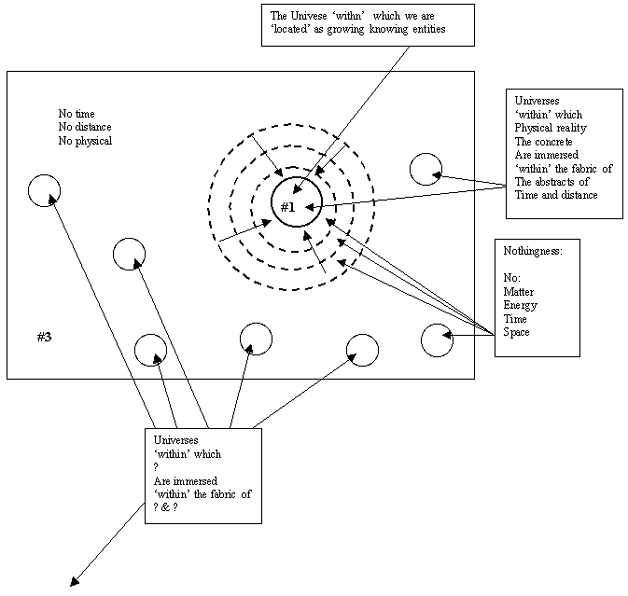
Questions arise:
Is the first question mark replaced by the physical? It may be but it need not be. This capability allows the whole to be much more complex than if the answer were simply yes.
The second question which arises is: Are the remaining two question marks the abstractual concepts of time and distance/space? Again the answer is the same, they may be or they may not be.
Is there anything we can say about the three question marks? Yes, we can be fairly certain the last two question marks are forms of abstractions since the reality of universes is that they all lie ‘within’ abstractual existence.
The questions then become: Is either the basic concept of centricism or the basic concept of non-Centricism or both simultaneously for that matter, found to be an innate characteristic of ‘nothingness’ itself?
Centricism is a characteristic. As such Centricism must apply to ‘some’ concept be it physical or abstractual.
The concept of ‘characteristics’ do not apply to ‘nothingness’ rather the void of characteristics apply to ‘nothingness’. Characteristics cannot ‘characterize’ ‘nothingness’, since ‘nothingness’ is neither physical nor abstractual. As such, it is only ‘within’ ‘nothingness’ where we find the lack of one or the other or both Centricism and non-Centricism.
Where do understandings regarding the characteristics of ‘inverse proportionality’, ‘nothingness’, ‘entities of knowing’, ‘Centricism’, and ‘non-Centricism’ lead us? Such understandings lead us toward comprehending the interaction as well as the interrelationship of the elements of the ‘whole’. Since by definition we are a part of the whole, such understandings lead us toward comprehending the interaction as well as the interrelationship of ourselves to the whole..
Before we can explore such interrelationships and interactions, we have two other concepts, which need addressing.
Virgin physicality/’virgin physical life’
The concept: ‘Nothingness’ found ‘within’ the physical, found ‘within’ region #1 is ‘Centricism’ itself. In fact, ‘nothingness’ found ‘within’ the physical is the ‘fundamental building block’ of the physical, is a concept for the field of science/cosmology to explore.
We find ourselves in the middle of a dialectic regarding the differences of existing within a region of Centricism (region #1) and a region of non-Centricism (region #3). The similarities of the two regions, as well as the significance one region imposes upon the other, are the concepts we are attempting to understand. We can begin our understanding by making a simple statement:
‘Nothingness’ found ‘within’ the physical, found ‘within’ region #1, is centricism itself.
To understand the concept: ‘Nothingness’ found ‘within’ the physical, found ‘within’ region #1, is centricism itself, we will once again rely upon graphics:
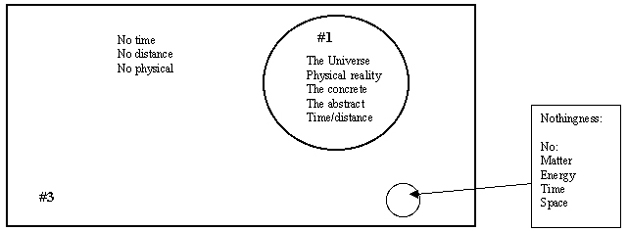
We will now expand the universe to include ‘nothingness’:
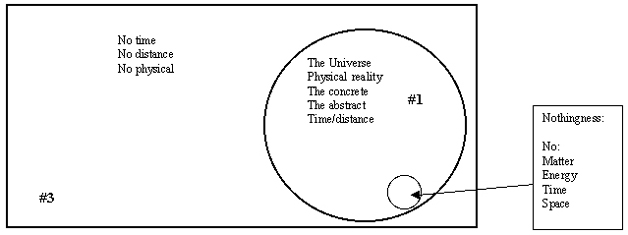
As we have discussed previously, nature abhors a vacuum and as such rushes to fill the vacuum. But nature acts symmetrically and as such nature rushes to fill the vacuum equally from all ‘directions’ until the vacuum is no longer a vacuum. The point is the vacuum collapses from the ‘outer’ edge toward the ‘center’. Within the physical, ‘nothingness’ is the location towards which all ‘things’ move to find the center.
‘Nothingness’ becomes the epitome of the center itself. ‘Nothingness’ becomes the center for as ‘nothingness’ becomes ‘occupied’ and its radius diminishes to non-existence itself, ‘nothing’ has occurred no ‘space’ was lost and no ‘distance’ traversed. Since no distance was traversed, no time was taken to fill the region of ‘nothingness’. This statement can be made when referring to time for time is not an element, is not a part of the fabric of which ‘nothingness’ is composed since by definition ‘nothingness’ is the void of all including not only matter and energy but also distance and time.
What then is: ‘Virgin physicality/’virgin physical life’? ’Virgin physical life’ is physical life at the point of centricism’s formation. ‘Virgin physicality’ begins just before formation but just after it pre-existed as separation. ‘Virgin physical life’ is the point of origination, is physical life ‘before’ it has gained the ability to physically function as singularity of existence versus multiple independent existence of components. ‘Virgin physicality’ is physical existence as ‘a’ unit versus existence as separate components ‘capable’ of combining to form ‘a’ unit. ‘Virgin physical existence’ is in essence nonexistence, is in essence nothing, is in essence ‘nothingness’ itself. ‘Virgin physicality/’virgin physical life’ is the moment ‘before’ space, time, matter, energy forms of experience become a part of knowing and thus knows nothing of its own self for its own self has yet to begin its process of knowing. The lack of knowing existing immediately before the process of knowing begins is where ‘virgin-ness’ lies. Virgin-ness lies at the center of ‘nothingness’ itself. Cosmologically and ontologically, centricism thus finds its ultimate source of centricity.
What then of the universe? Science and religion with their principles of symmetry and creation would suggest the same concept can be applied to this thing we call ‘virgin physicality’. Again, however, this is a discourse for science/cosmology and religion/ontology to explore. Our task is metaphysical in nature and although our discussion may have direct implication for science and religion, it is not the scientific nor the religious aspects we are to pursue.
What then are we attempting to explore? We are attempting to explore the concept of knowledge becoming ‘knowing’ knowledge, consciousness of ‘knowledge’.
We will, therefore, modify our graphic by replacing the symmetrical circle within which we find three dimensions, four dimensions, and may in the future find five, six, and more dimensions. with a unit entity of ‘knowing’: In short, we are about to explore the concept of: Virgin consciousness/’virgin abstract knowing’.
Virgin consciousness/’virgin abstract knowing’:
We can now make a second statement regarding the concept of ‘nothingness’
‘Nothingness’ found ‘within’ the abstract, found ‘within’ region #3 is ‘non-Centricism’ itself.
It could be said that the statement: ‘Nothingness’ found ‘within’ the abstract is the ‘fundamental building block’ of the abstract. is a concept for the field of religion/ontology to explore.
We find ourselves in the middle of a dialect regarding the differences of existing within a region of Centricism (region #1) as explained by cosmology and existing in a region of non-Centricism (region #3) as explained by ontology. This is the very point of metaphysics. Metaphysics listens to both cosmology and ontology and attempts to resolve the issues keeping the two apart.
Before we can make the leap of resolving the basic differences between ontology and cosmology, we must allow the metaphysical understanding regarding the ontological perception of ‘nothingness’ to emerge just as we allowed the metaphysical understanding regarding the cosmological perception of ‘nothingness’ to emerge.
To understand the concept: ‘Nothingness’ found ‘within’ the abstract, found ‘within’ region #3, is non-Centricism itself. we will once again rely upon graphics:
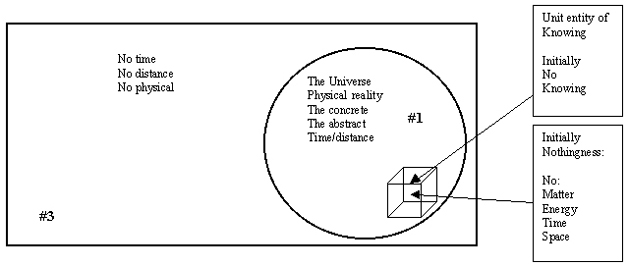
As the entity moves through time and space, it gains an ‘awareness’ of experiencing. The entity begins to ‘fill’ up with both knowing and awareness of its knowing. Eventually, the entity becomes ‘full’. The ‘fullness’ of the entity does not terminate the entity’s existence in the physical. Rather the termination of the entity’s existence in the physical completes the filling of the entity.
This does not imply the entity has ‘room’ for more knowing, for the entity is always ‘full’. Rather the physical termination is the termination of the ‘process’ of acquiring knowledge by the knowing of the entity.
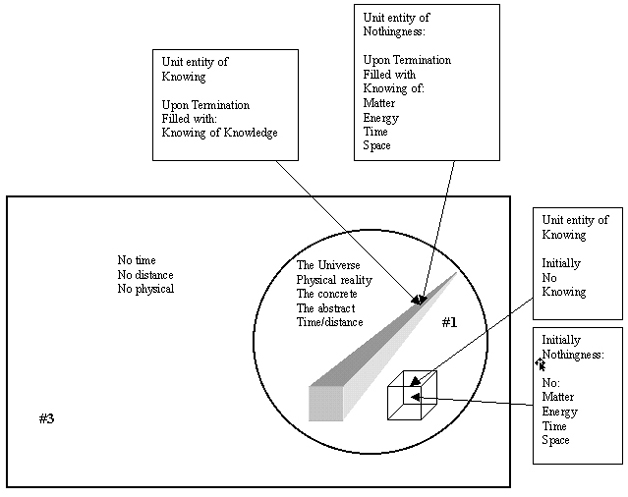
We can depict the completion of the process as a ‘filled’ versus an ‘empty’ unit. Regardless of the ‘amount’ of knowledge ‘contained’ within the entity of knowing, the concept of the entity being completely filled is complete with the termination of gaining knowing unique to the entity of knowing.
Likewise, regardless of the ‘amount’ of knowledge ‘contained’ within the entity of knowing the concept of the entity being completely empty while in the process of gaining knowing unique to the entity of knowing is in essence ‘empty’ relative to the potential to gain knowledge by the entity of knowing. The only limit imposed to the continued increase in knowledge forced upon the unit of knowing is the termination of the process itself.
Some would call this termination of the growth process of ‘knowledge’ by the unit of knowing, death. There is nothing inappropriate regarding this label. However, to say we ‘know’ what death is, is inappropriate for we can only speculate regarding such a meaning. In this Tractate, we are exploring the very meaning of the term death, from a different direction than that which society presently comes. We are exploring the perception of death - exploring the perception of the mirror separating the physical and the abstract from the point of view of a new metaphysical perception.
What then is: Virgin consciousness/’virgin abstract knowing’, ‘virgin abstract knowing’ is knowing at its point of origination, is knowing ‘before’ it has gained any knowledge and thus its knowing knows nothing. Virgin consciousness/’virgin abstract knowing’ is the moment ‘before’ space, time, matter, and energy forms of experience become a part of knowing. Virgin consciousness knows nothing of its own self for its own self has yet to begin its process of knowing. The lack of knowing existing immediately before the process of knowing begins is where ‘virgin-ness’ lies. Virgin-ness lies at the center of the ‘nothingness’ of knowing itself. Metaphysically, centricism thus finds its ultimate source of centricity.
Stepping ‘in’ beyond Centricism: Dependency
Now as much as it may appear logical to begin examining the entities of knowing within region #1, we are going to begin examining the entities of knowing from region #3. To do this we will simply move the entities of knowing out of region #1 and into region #3.
In essence, we are going to step ‘out’ into non-Centricism. We are going to allow the two forms of unique knowing of knowledge to step ‘out’ into non-Centricism.
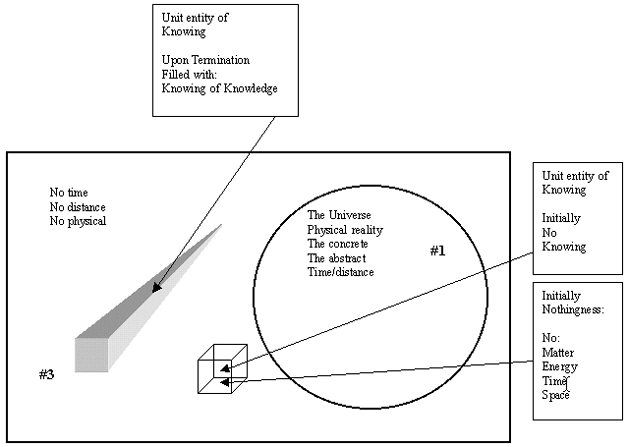
Since the ‘empty’ unit, the ‘virgin entity of knowing’, has absolutely nothing abstractual or otherwise within it, it takes up no space or time and thus we can now simplify the graphic:
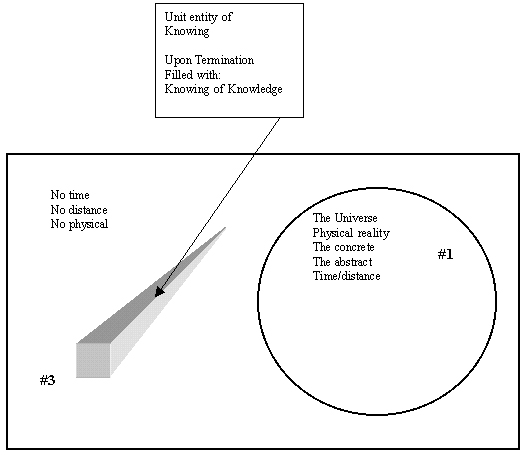
With the aid of this graphic, we can now begin to understand the interrelationship between existing entities found within region #3. We can now begin to understand the very concept of not only the very existence of non-Centricism itself but we can begin to understand the process as well as the potentiality of non-Centricism.
Existence within non-Centricism:
We will take the latter diagram and reduce region #1, the location of Centricism since we are concerned with region #3. In addition we will expand upon the number of entities of knowing which have evolved through the process of ‘traveling’, experiencing region #1 – the location of space, time, matter, energy…:
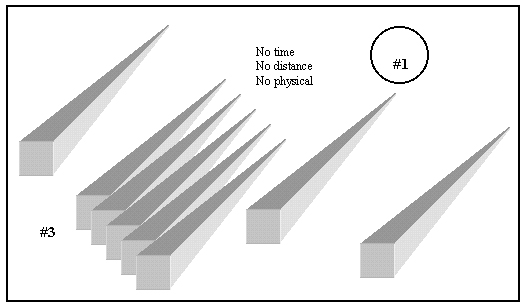
The entities of knowing:
- Are each unique in and of themselves due to their unique experiencing and assembly through time and space or whichever abstractual fabric should exist within the ‘universe’ from which they emerge
- Do not vary in size since relative to the whole, each is relatively the same in size
- May appear to vary regarding their ‘distance’ apart but since they are immersed in a location void distance, in essence the ‘distance’ separating them does not exist. They are, therefore, all equidistant – no distance apart
- Are independent of beginning – end parameters since they are immersed in a void of time and space, immersed within a form of non-Centricism
Process
- Take no ‘time’ to get from one to another since there is no ‘distance’ to traverse
- Are capable of ‘knowing’ one another completely since they are not knowledge but passive unique experiencing of knowledge assembled by the active process of knowing and whose process remains an integral part of themselves since the passivity of knowledge is nothing without active process of knowing
Potentiality
- Are capable of incorporating ‘new’ entities of unique knowledge, knowing, and experiencing
- Partial summations of knowing as well as complete summations of knowing are as varied as the potential combinations of existing entities and the parts of existing entities allow. This is known as ‘Omniscience’.
- Potentiality within region #3 is, due to #1 – 8 is limited to what is and therefore is ‘dependent’ one entity upon another entity, which exists as opposed to what ‘might’ exist.
Dependence thus becomes the principle of region #3.
It must be acknowledged that the concept of existence ‘within’ non-Centricism is a difficult concept to comprehend. But why shouldn’t it be. We are after all immersed ‘within’ Centricism’ and as such find time and space to be concepts expanding ‘outward’ from ‘a’ point of reference which varies from conscious knowing to conscious knowing.
What must not be lost within the exploration of the unfamiliar, however, is that within a location void the fabric of space and time, ‘correct’ sequencing is not a fundamental principle since ‘correct’ sequencing is an aspect of time and space found within our personal universe.
Region #3 therefore is a location where our unique experiencing depends upon what others have to offer us to experience versus our forming our own experiencing for our own unique experiences are what they are and our own uniqueness cannot change without the infusion, embracing, union of another’s unique knowing.
Divine intervention? Perhaps. Who is to say what the whole is capable of doing with its creation: the universe, our reality.
Nevertheless, how can an ‘all knowing’ entity be all knowing if it doesn’t know ‘all things’?
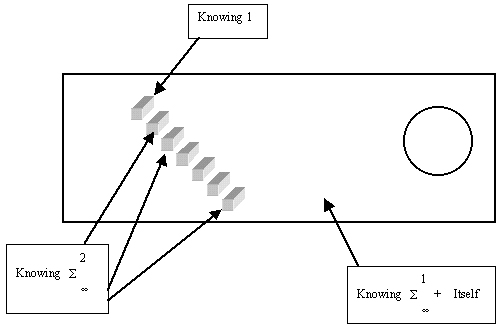
Doesn’t this diagram imply ‘all Knowing’ doesn’t know what ‘will be’ and doesn’t this in turn imply time exists in ‘all Knowing’?
|
|
|




































